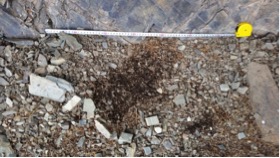Earlier this month, various media outlets reported that snow leopards ‘may be more common than thought’. The articles were quoting a recently published book (1) on these endangered cats, in which a group of authors make the claim that the snow leopard population could be much higher than prevailing estimates suggest. We wish this were the case. Unfortunately, there is no reliable scientific evidence for this claim, and it is misleading and potentially damaging to conservation efforts.
Snow leopards live across a vast and often inaccessible mountain territory. Some individual cats use home ranges that can be several hundred square kilometers large, while others are reported to use just a few dozen square kilometers. These factors make it extremely challenging to reliably count and monitor snow leopard populations. In fact, only about 1.5% of the total snow leopard range has been surveyed with reliable, internationally accepted methods such as intensive camera studies or genetic analysis of feces, and available population estimates vary accordingly. Currently, most experts assume a number between 3920 and 7500 – conscious of the fact that it’s essentially a guesstimate.
And yet, authors of this recent book chapter present new figures of up to 8,745 cats – and they claim that those numbers represent just ’44% of their range’; of course suggesting that the number across the total range may actually be significantly higher still. How is that possible, when a mere 1.5% of the total range surveyed has been surveyed using acceptable abundance estimation methods?
To arrive at these numbers, the authors have summed up regional estimates from various, in some cases unspecified sources – many of them dating back to an assessment that was done in 2008.
Most of these regional estimates are themselves not much more than educated guesses – as even the authors themselves say. For instance, ‘habitat quality’ is used as one of the indicators behind the estimate for Pakistan’s Central Karakoram area, while for certain parts of China, ‘questionnaires’ and ‘informed estimates’ provide the baseline data, according to the authors.
Other regional estimates are derived from so-called sign surveys – studies where researchers count snow leopard scat or other signs such as scrape marks within a relatively small area, and then extrapolate population numbers in a larger landscape from these findings.

Scrape marks can be a sign of snow leopard presence – but they don’t make a good basis for population estimates.
In contrast, only a very small fraction of the studies used to arrive at this new, significantly higher global estimate is based on scientifically sound methods such as camera trapping or genetic analysis of feces.
In short, just like previous numbers, these population figures are once again simply guesstimates – and there is nothing in them that would suggest they’d be any more accurate than the prevailing ones.
In fact, there is a possibility that the prevailing estimates may just as likely be too high. Recent, scientifically population surveys based on camera trapping and fecal genetics in Pakistan and Nepal, for instance, suggest that the actual snow leopard populations in these countries may be significantly lower than we thought. It would be premature to take these results as evidence of a much lower population overall, but they’re certainly cause for concern.
Recent data from Pakistan suggests that there may well be fewer snow leopards in the country than previously estimated.
In fact, the area covered by the authors’ estimate is larger than all of the confirmed and probable snow leopard habitat combined – in other words, it contains all the areas we know or strongly suspect the cats occur in.
The remaining 56% of the range in their calculation represents what is referred to as ‘possible’ snow leopard habitat – areas that have all the ecological features the cats need, but haven’t been confirmed to actually have any snow leopards. Some of these areas almost certainly do, and others probably don’t. Even if the estimates for the 44% of the range the authors present were scientifically convincing (which they are not), it wouldn’t do to simply assume that these other, largely unexplored areas will all have roughly the same average snow leopard densities as some of the more well-studied habitats.

The snow leopard range, according to the GSLEP program. Less than 1.5% of the blue area has been surveyed for snow leopards with scientifically sound methods
Let’s not engage in numbers games, but instead make every effort to scale up research and conservation efforts for this endangered cat!
__________________
(1) McCarthy, T., Mallon, D., Sanderson, E.W., Zahler, P. and Fisher, K.: Chapter 3: What is a Snow Leopard? Biogeography and Status Overview. In: Nyhuis, P.J., McCarthy, T., and Mallon, D. (Eds.): Biodiversity of the World: Conservation from Genes to Landscapes. 1st Edition. Snow Leopards. Elsevier Press, 2016, p. 22-42.
source
No comments:
Post a Comment